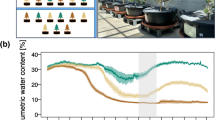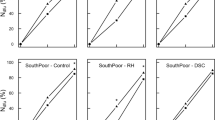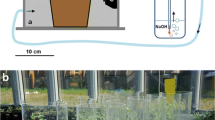Abstract
Carbon dioxide is released from the soil to the atmosphere in heterotrophic respiration when the dead organic matter is used for substrates for soil micro-organisms and soil animals. Respiration of roots and mycorrhiza is another major source of carbon dioxide in soil CO2 efflux. The partitioning of these two fluxes is essential for understanding the carbon balance of forest ecosystems and for modelling the carbon cycle within these ecosystems. In this study, we determined the carbon balance of three common tree species in boreal forest zone, Scots pine, Norway spruce, and Silver birch with gas exchange measurements conducted in laboratory in controlled temperature and light conditions. We also studied the allocation pattern of assimilated carbon with 14C pulse labelling experiment. The photosynthetic light responses of the tree species were substantially different. The maximum photosynthetic capacity (P max) was 2.21 μg CO2 s−1 g−1 in Scots pine, 1.22 μg CO2 s−1 g−1 in Norway spruce and 3.01 μg CO2 s−1 g−1 in Silver birch seedlings. According to the pulse labelling experiments, 43–75% of the assimilated carbon remained in the aboveground parts of the seedlings. The amount of carbon allocated to root and rhizosphere respiration was about 9–26%, and the amount of carbon allocated to root and ectomycorrhizal biomass about 13–21% of the total assimilated CO2. The 14CO2 pulse reached the root system within few hours after the labelling and most of the pulse had passed the root system after 48 h. The transport rate of carbon from shoot to roots was fastest in Silver birch seedlings.





Similar content being viewed by others
References
Arovaara H, Ilvesniemi H (1990) The effects of soluble inorganic aluminium and nutrient imbalances on Pinus sylvestris and Picea abies seedlings. In: Kauppi P, Kenttämies K, Anttila P (eds) Acidification in Finland. Springer, Berlin, pp 715–733
Bowden RD, Nadelhoffer KJ, Boone RD, Melillo JM, Garrison JB (1993) Contributions of aboveground litter, belowground litter, and root respiration to total soil respiration in a temperate mixed hardwood forest. Can J For Res 23:1402–1407. doi:10.1139/x93-177
Bowling DR, Sargent SD, Tanner BD, Ehleringer JR (2003) Tunable diode laser absorption spectroscopy for stable isotope studies of ecosystem–atmosphere CO2 exchange. Agric For Meteorol 118:1–19. doi:10.1016/S0168-1923(03)00074-1
Buchmann N, Brooks JR, Ehleringer JR (2002) Predicting daytime carbon isotope ratios of atmospheric CO2 within forest canopies. Funct Ecol 16:49–57. doi:10.1046/j.0269-8463.2001.00591.x
Cajander AK (1949) Forest types and their significance. Acta For Fenn 56:1–71
Chapin FS III, Matson PA, Mooney HA (1999) Gross primary production. In: Principles of terrestrial ecology. Springer, Berlin, pp 117
Davidson EA, Belk E, Boone RD (1998) Soil water content and temperature as independent or confounded factors controlling soil respiration in a temperate mixed hardwood forest. Glob Chang Biol 4:217–227. doi:10.1046/j.1365-2486.1998.00128.x
Ekblad A, Boström B, Holm A, Comstedt D (2005) Forest soil respiration rate and δ13C is regulated by recent above ground weather conditions. Oecologia 143:136–142. doi:10.1007/s00442-004-1776-z
Ewel KC, Cropper WP Jr, Gholz HL (1987) Soil CO2 evolution in Florida slash pine plantations. II. Importance of root respiration. Can J For Res 17:330–333. doi:10.1139/x87-055
Gordon JC, Larson PR (1970) Redistribution of 14C labeled reserve food in young red pines during shoot elongation. For Sci 16(1):14–20
Hanson PJ, Edwards NT, Garten CT, Andrews JA (2000) Separating root and soil microbial contributions to soil respiration: a review of methods and observations. Biogeochemistry 48:115–146. doi:10.1023/A:1006244819642
Heinonsalo J, Sen R (2007) Scots pine ectomycorrhizal fungi inoculum potential and dynamics in podzol-specific humus, eluvial and illuvial horizons one and four growth seasons after forest clear-cut logging. Can J For Res 37(2):404–414. doi:10.1139/X06-212
Heinonsalo J, Jørgensen K, Sen R (2001) Microcosm-based analyses of Scots pine seedling growth, ectomycorrhizal fungal community structure and bacterial carbon utilization profiles in boreal forest humus and underlying illuvial mineral horizons. FEMS Microbiol Ecol 35:73–84. doi:10.1111/j.1574-6941.2001.tb00827.x
Heinonsalo J, Hurme K-R, Sen R (2004) Recent 14C-labelled assimilate allocation to Scots pine seedling root and mycorrhizosphere compartments developed on reconstructed podzol humus, E- and B-mineral horizons. Plant Soil 259(1):111–121. doi:10.1023/B:PLSO.0000020939.64205.c4
Högberg P, Read D (2006) Towards a more plant physiological perspective on soil ecology. Trends Ecol Evol 21(10):548–554. doi:10.1016/j.tree.2006.06.004
Högberg P, Nordgren A, Buchmann N, Taylor AFS, Ekblad A, Högberg MN, Nyberg G, Ottosson-Löfvenius M, Read DJ (2001) Large-scale forest girdling shows that current photosynthesis drives soil respiration. Nature 411:789–792. doi:10.1038/35081058
Kirschbaum MUF (1995) The temperature dependence of soil organic matter decomposition, and the effect of global warming on soil organic C storage. Soil Biol Biochem 27(6):753–760. doi:10.1016/0038-0717(94)00242-S
Knohl A, Werner RA, Brand WA, Buchmann N (2005) Short-term variations in δ13C of ecosystem respiration reveals link between assimilation and respiration in a deciduous forest. Ecosyst Ecol 142:70–82
Konôpka B, Curiel JC, Janssens IA, Ceulemans R (2005) Comparison of fine root dynamics in Scots pine and pedunculate oak in sandy soil. Plant Soil 276:33–45. doi:10.1007/s11104-004-2976-3
Kozlowski TT (1992) Carbohydrate sources and sinks in woody-plants. Bot Rev 58(2):107–222. doi:10.1007/BF02858600
Kramer PJ, Kozlowski TT (1960) Physiology of Trees. McGraw-Hill, New York, p 338
Kramer PJ, Kozlowski TT (1979) Physiology of woody plants. Academic Press, New York, pp 373–391, 445–493
Kuzyakov Y, Biryukova OV, Kuznetzova TV, Mölter K, Kandeler E, Stahr K (2002) Carbon partitioning in plant and soil, carbon dioxide fluxes and enzyme activities as affected by cutting ryegrass. Biol Fertil Soils 35:348–358. doi:10.1007/s00374-002-0480-6
Lippu J (1994) Patterns of dry matter partitioning and 14C-photosynthate allocation in 1.5-year-old Scots pine seedlings. Silva Fenn 28(3):145–153
Maier CA, Kress LW (2000) Soil CO2 evolution and root respiration in 11-year-old loblolly pine (Pinus taeda) plantations as affected by moisture and nutrient availability. Can J For Res 30:347–359. doi:10.1139/cjfr-30-3-347
Nakane K, Yamamoto M, Tsubota H (1983) Estimation of root respiration rate in a mature forest ecosystem. Jpn J Ecol 33:397–408
Nakane K, Kohno T, Horikoshi T (1996) Root respiration rate before and just after clear-felling in a mature, deciduous, broad-leaved forest. Ecol Res 11:111–119. doi:10.1007/BF02347678
Prescott CE, Zabek LM, Staley CL, Kabzems R (2000) Decomposition of broadleaf and needle litter in forests of British Columbia: influences of litter type, forest type, and litter mixtures. Can J For Res 30:1742–1750. doi:10.1139/cjfr-30-11-1742
Schneider A, Schmitz K (1989) Seasonal course of translocation and distribution of 14C-labelled photoassimilate in young trees of Larix decidua Mill. Trees (Berl) 4:185–191
Thompson RG, Fensom DS, Anderson RR, Drouin R, Leiper W (1979) Translocation of 14C from leaves of Helianthus, Heracleum, Nymphoides, Ipomoea, Tropaeolum, Zea, Fraxinus, Ulmus, Picea and Pinus: comparative shapes and some fine structure profiles. Can J Bot 57:845–863. doi:10.1139/b79-106
Wu B, Nara K, Hogetsu T (2001) Can 14C-labeled photosynthetic products move between Pinus densiflora seedlings linked by ectomycorrhizal mycelia? New Phytol 149:137–146. doi:10.1046/j.1469-8137.2001.00010.x
Wu B, Nara K, Hogetsu T (2002) Spatiotemporal transfer of carbon-14-labelled photosynthate from ectomycorrhizal Pinus densiflora seedlings to extraradical mycelia. Mycorrhiza 12:83–88. doi:10.1007/s00572-001-0157-2
Zimmermann MH (1958) Translocation of organic substances in the phloem of trees. In: Thiman KV (ed) The physiology of forest trees. Ronald Press, New York, pp 381–400
Author information
Authors and Affiliations
Corresponding author
Additional information
Communicated by T. Hogetsu.
Rights and permissions
About this article
Cite this article
Pumpanen, J.S., Heinonsalo, J., Rasilo, T. et al. Carbon balance and allocation of assimilated CO2 in Scots pine, Norway spruce, and Silver birch seedlings determined with gas exchange measurements and 14C pulse labelling. Trees 23, 611–621 (2009). https://doi.org/10.1007/s00468-008-0306-8
Received:
Revised:
Accepted:
Published:
Issue Date:
DOI: https://doi.org/10.1007/s00468-008-0306-8




